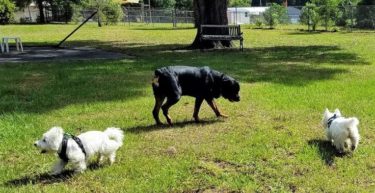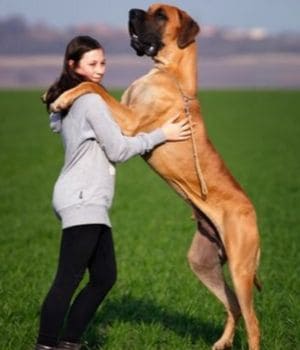I’ve gotta say, it sure doesn’t seem like my big dog knows how big he is when he climbs up on my lap exactly as he did when he was a puppy! If you’ve spent any time around a big dog, you may think the same thing, that he (or she) has NO clue as to their size. Today we’re going to take a closer look at what we know dogs know and determine how to utilize this information to our advantage. I can tell you for sure the short answer to Do Big Dogs know They are is Yes, they know. But there’s more to it than a “yes or no”. Shall we take a closer look?
I’m glad you landed in the Big Dog Den. Welcome! I was fascinated by what I learned in my research about whether or not big dogs are aware of their size, and will share everything I discovered with you right here and right now. In this article, you’ll find out:
- How Science Determines What Dogs Know
- How Dogs “Measure” the Size of Other Dogs
- What Proves That Big Dogs Know How Big They Are
- Why Some Big Dogs Don’t Seem to Know They’re Big
- How to Encourage Your Big Dog to Act His Size
…and SO much more! Let’s start “measuring” the evidence, and see what conclusion we can draw about how the information pertains to our own experience with a big dog!
How Do We Know What a Big Dog Knows About Size?
As technology and ethics improve, we know so much more about the things we once only assumed about animals. Since this is an article about big dogs knowing their size, today’s information is related to that subject alone. We’ve learned what a dog knows about size (his own and the other animals, humans, or things around him) through extensive testing and controlled experiments.
I’m happy to say that animal testing has come a long way from where it began. Modern tests for cognizance and intelligence in dogs are humane and keep the dog’s well-being a priority.
All sizes of dogs are used in testing, and all breeds, to come up with the most informative conclusions possible. Of course, there will be dogs who score “outside the box” when it comes to testing cognitive thinking skills, but the conclusions are drawn based on the majority system of testing results.
DID YOU KNOW? Dogs have a brain structure that produces emotions much like a human’s. They have the same hormones and undergo the same chemical changes during emotional situations like fear and joy. Dogs even produce the hormone oxytocin, which is responsible for feelings of love and affection!
Do Dogs Know How Big Other Dogs Are?
When it comes to size perception as it pertains to one dog determining the size of other dogs, two aids were used in testing; visual and audio. The name of the experiment was the “Taylor Experiment” and here’s how it went down. Toy “stuffed” dogs were put in the line of a dog’s vision. Next, a recording of either a large dog or a small dog growling was played.
The scientists reported that the dog being tested consistently looked at the stuffed animal that was closer in size to the recording being played. So much so that if the small stuffed was present when the big dog recording was played, the dog being tested didn’t even glance toward the stuffed animal. The dogs knew the sound wasn’t right for the size of the stuffed dog. Hence, no threat was even perceived.
The conclusion drawn from the Taylor Experiment is that dogs use both vision and hearing to determine the size of another dog. This ability to match visual and acoustic cues was a level of cognitive thinking once only attributed to primates.
The size of another dog matters to your dog for a couple of reasons. The most obvious reason is threat detection. When that ankle-high Chihuahua is yapping at your big dog, your dog knows without a doubt that the Chihuahua is no threat to him. Should a big dog react (or even retaliate) to the smaller dog, it is likely out of annoyance rather than an actual sense of feeling threatened.
When nature is calling, dogs will instinctively desire to breed with a dog of about the same size. It is highly unusual for a large breed male to attempt a coupling with a small breed female. Of course, it has happened when the only female available to the male is in heat. However, if five different-sized females in heat were available to the large breed male, he would couple with the female closest to his size. Pretty cool, huh?
If you’d like to learn more about breeding different sized dogs, you won’t want to miss “Can a Big Dog Breed With a Small Dog?” right here in the Big Dog Den!
DID YOU KNOW? It is not uncommon for a spayed dog to still exhibit signs of going in heat that will attract male dogs to her.

Proof that Big Dogs Know They’re Big
Perhaps the best proof of a big dog knowing his own size I have seen to date is watching a 130 pound (60kg) Rottweiler playing with a 2 pound (.9kg) kitten. The Rottweiler, Maximus, has had ample opportunities to frolic with other dogs his own size, and they can play quite rough! With the kitten, though, Max is gentle and patient. So much so that the kitten initiates playtime often, and has absolutely no fear of the dog who could easily do great harm to the cat, if that were his intention.
Humans who have small children around big dogs will also attest to the dog knowing his size. A big dog interacts much differently during playtime, friends tell me, with a toddler than they do with an adult. It’s crucial that I remind you to never leave a young child unattended with a big dog though, or any dog for that matter.
This is because no matter how well-trained a dog is, he is still a dog who will act on instincts. If he is hurt, surprised, or feels threatened, he will react. For this reason, it is equally as important to train a child to be around dogs as it is to train a dog to be around children.
Another place we can witness a big dog knowing his size is in the physical abilities arena. My friend has two dogs, one small and one big. The fence in my friend’s back yard easily keeps the small dog contained. In fact, the smaller dog has never even tried to jump over it, a feat the bigger dog accomplished on his first romp through the yard. The bigger dog knew it was within his capabilities to scale the fence, and he went over it without hesitation or reservation. he knew he was big enough, and the smaller dog knew he wasn’t.
DID YOU KNOW? Most big dogs can easily jump 6 feet (1.8 meters) into the air!
Why Big Dogs Act Like Small Dogs
We have to do a little guesswork in this section because a dog never answers when we ask why he thinks he’s a lapdog, LOL! Since it’s been scientifically determined that a big dog knows he’s big, we can only assume the dog doesn’t understand how his size relates when it comes to certain things… like our lap. Perhaps he is simply carrying out the same behaviors he exhibited as a small pup, or perhaps he is just determined to do the things he likes (or wants) to do!
If you compared a dog’s IQ to a human’s, he would rank with a two-year-old in cognitive thinking skills. Both are able to understand up to 250 words and gestures. Both know when you’re away, and both have a sense of whether you’ve been away for a short while or long. Both are quick to remember how to get a treat and quick to forget what their behavior limitations are. Both a two-year-old child and a dog will need to be reminded of their boundaries often.
DID YOU KNOW? The part of a dog’s brain that processes and governs his sense of smell is 40% larger than a human’s. Your dog senses your mood through smell, and that is also how a dog knows when a human is sick or pregnant. Imagine if that’s how we “read” each other… through a thorough sniffing, LOL!

Helping Your Big Dog Act Like a Big Dog
Having a big dog that acts in the appropriate “big dog” manner will boil down to one thing: his (or her) training. If you don’t want to share your bed or your sofa with a dog that weighs almost as much as a full-grown human, then don’t allow the dog to sleep with you or climb on the furniture when he’s a puppy.
Training begins the day after you bring your dog home. I always recommend you enroll your big dog in obedience classes, but these should be a supplement to the training you do daily with him. Every interaction you have with your big dog is an opportunity to hone his training and to strengthen the bond the two of you share.
Always begin training with the 5 Basic Commands. These are:
- Come! You will certainly want your dog to come to you when you call his name. This is the easiest command for your dog to master because he naturally wants to be where you are. To make learning this command fast and easy, reward your dog with praise and petting every time he heeds your call.
- Heel! This command will teach your dog to walk alongside you and at your pace. It will prevent him from lunging when on a leash or trotting off when not on a leash.
- Sit! This command isn’t a trick for a treat (although a treat is certainly a great way to teach him!), it is a serious command that will help your dog understand that you run the show and he (or she) does not. Your dog should be taught to sit while you ready his meal, while you answer the door, and anytime that you want him to be calm and controlled.
- Down! Again, there is a difference between the cute factor in a puppy jumping up on you and a full-grown large breed dog doing it. Teach him “Down!” when he is young! Do it patiently and kindly though, understanding that he is simply over-excited when he’s jumping on you. I like to begin with having the dog sit, and then progressing to having him lay all the way down.
- Stay! This is one of the more difficult commands to teach because, as we know, our dog wants to be with us. Right next to us! Begin teaching this command by having your dog sit. Then, issue the “Stay!” command and walk a few steps away. If he follows you, take him back to where you began and start over. This will take time and patience on your part. When he stays in position for about five seconds when you walk away, reward him with praise or a treat. Either reward demonstrates that you are pleased with him, and he will soon figure out that “Stay!” is a way he can please you, which is his goal in life. Gradually increase the distance between you and the dog as he improves on the length of time he will stay where he is told.
Treat a big dog like a big dog from the time he is a puppy. This will eliminate the need to change the rules when your dog reaches his maximum weight. Below are some handy tips to utilize when training your big dog from his youth:
- Establish furniture and bed boundaries: Think about where you will want your full-grown big dog to be allowed to sit or sleep and train him accordingly when he is still small.
- When entering or exiting your home with your dog, make sure you go through the doorway first. Always. This establishes leadership, and with a large breed dog, it is imperative that he (or she) knows you are the leader of your home.
- Designate a space for your dog that is “his own”, and use it consistently. My dog has a crate with a comfortable dog bed inside. When he was younger, I closed the door to the crate at night or when he just needed to “chill out” for a bit. It’s been a long time since I’ve had to close the door, though! My dog is comfortable and enjoys spending time in his place. If I have guests that aren’t “dog people” I will have him go in his place and enjoy a big ole bone from the butcher.
- Teach “lap respect”: At the risk of sounding repetitive, a puppy who grows fond of being on your lap will grow into a dog too big for your lap, but still quite fond of it. To avoid this issue in your big dog’s adulthood, avoid holding your puppy on your lap. Teach him to sit at your feet, instead, when petting him and showing him attention and affection. If the furniture will NOT be off-limits in his adulthood, have your puppy sit next to you for affection, and not on you. If furniture WILL be off-limits in his adulthood, take yourself down to your dog’s level for affection and playtime.
Most healthy dogs are naturally affectionate, and we don’t want to do anything that will discourage this wonderful trait. This is one of the reasons dogs are a man’s (and a woman’s) best friend. Even the biggest and “badest” guard dogs are loving toward their master! With a puppy who will grow to become a big dog, we just have to guide him toward gentleness in showing affection. Truth be told, I really don’t mind when my massive dog wants to play “lapdog”. It’s actually kind of fun (and funny)!
DID YOU KNOW? The “Australian Shepherd” dog breed did not originate in Australia. Rather, the breed was developed in the United States!
Did anything you discovered in today’s article surprise you? Some of the information I learned really surprised me! It would seem that my big dog knows EXACTLY how big he is… he just doesn’t care when it comes to showing me how much he loves me, LOL! I hope you’ll stop by the Big Dog Den again soon. Until then, take care of yourself… and your big dog! I’ll leave you today with one more interesting fact:
DID YOU KNOW? You may not have given much thought to why you’re a dog lover, but scientists have! Through studies conducted on identical twin humans who were not raised together, it is suggested that being a dog lover can be both or either; genetic or environmental. Although they don’t know exactly what part of our DNA may be drawn to dogs, scientists are optimistic that one day they will!
*This article has been reviewed in accordance with our editorial policy.
